The Camino de Santiago's ancient secret
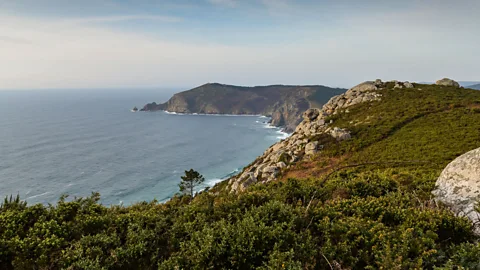 Olivier Guiberteau
Olivier GuiberteauCape Finisterre’s mythical pull has drawn travellers since the time of antiquity. But with the rise of Christianity, the route to ‘the end of the world’ became all but forgotten.
A simple bronze walking boot sits on a rock overlooking the immense vastness of the Atlantic Ocean. There is no plaque, but the message is manifest. This is the end of the road.
It is also ‘the end of the world’.
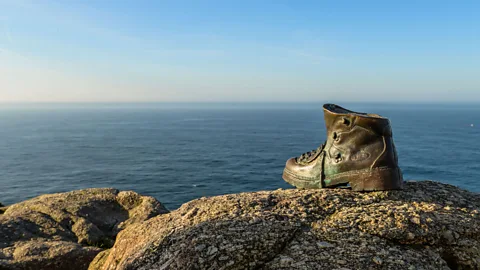 Olivier Guiberteau
Olivier GuiberteauThe snaking routes of the Camino de Santiago pilgrimage convene at the cathedral in Santiago de Compostela, the capital of north-west Spain’s Galicia region and the alleged burial site of St James. For more than 1,000 years, people have made their way along these paths to pay homage to the apostle, but for a small number of travellers who arrive in the hallowed city, the journey isn’t yet complete.
You may also be interested in:
• A perilous walkway fit for kings
From the city’s main square, another, lesser-known path creeps west. The cathedral spires fade into the distance as the trail leaves the city and continues for 90km to the raging beast that is the Atlantic Ocean – and Cape Finisterre. Taken from the Latin words finis, meaning ‘end’, and terra meaning ‘Earth’, this windswept corner of Spain has a spiritual history stretching back more than four millennia.
Geographically speaking, Cape Finisterre is of course not the end of the world – nor even the most westerly point of mainland Europe as is sometimes claimed (Cape Roca in Portugal holds this distinction). But Cape Finisterre is an area whose mythical pull has drawn travellers since the time of antiquity. Pilgrims were brought here by religion, by adventure or simply to stand at the edge of the then-known world and stare out at the Mare Tenebrosum, the Sea of Darkness.
Since 1500, this stretch of coastline, forebodingly known to locals as Costa da Morte, or Coast of Death, has witnessed numerous major shipwrecks. The weather can be violently unpredictable, with merciless rocky outcrops to match. Spain’s worst ecological disaster began here on 13 November 2002, when the oil tanker Prestige was caught in a storm off the coast of Finisterre and sank a week later.
The small town of Fisterra sits above a south-facing promontory, Monte Facho, a gentle hill with commanding views around it. Fisterra is like many other towns on this stretch of coast; wrapped around a quaint fishing port with a long beach curling east, away from the ocean. In truth, it is far from the rip-roaring, ‘end-of-the world’ town you might imagine.
 Olivier Guiberteau
Olivier GuiberteauThe Romans named those who lived here Gallaeci – Celts – because their light skin and fair hair resembled that of the tribes in Gaul – now . The Gallaeci were animists, meaning they held strong beliefs that everything in the physical world, be it the sun, stars, rocks, trees or water, all possessed a spiritual entity. “There is a significance about rocks and water coming together, because they are of course both non-negotiable, and there’s a deep human emotion connected with these natural elements,” said Colin Jones, chairman of the Confraternity of St James, an organisation specialising in information on the Camino de Santiago.
The densely forested Monte Facho, criss-crossed by small trails, rises to a height of nearly 240m. Its eastern face gently rolls down into the town, while the western flank plummets dramatically into the Atlantic Ocean. Nestled in the undergrowth on the eastern side, overlooking the harbour, lie the ruins of the San Guillermo Hermitage. It was at this same spot that the conquering Romans first set eyes on a simple stone temple built by the Gallaeci to honour the sun – the Ara Solis – consisting of four granite columns and a slender dome above, as described by Galician historian Benito Vicetto. Sadly, nothing remains today of the Ara Solis, which is believed to have been a place of pagan sun worship.
For the Romans, the Ara Solis, situated at what they considered the end of the known world and facing the setting sun each evening, must have been a captivating and enigmatic sight.
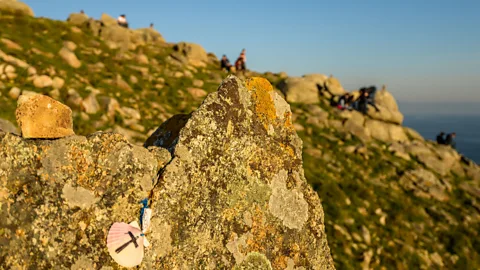 Olivier Guiberteau
Olivier GuiberteauWord of the untamed land at the end of the world began to spread through the Roman Empire and beyond, and travellers began making their way to Cape Finisterre to see the site for themselves. It was described in Pliny the Elder’s Natural History written in 77 AD, and by Ptolemy in his Geographia in 150 AD, who initially used the names Nerium or Promunturium Celticum, meaning Celtic Promontory.
The rise of Christianity, especially during the 3rd and 4th Centuries AD, would prove at odds with animist beliefs. St James himself was said to have demolished the Ara Solis. It’s a fanciful story, and unfortunately one that is impossible to substantiate. In the 7th or 8th Century, the hermitage was built by a medieval traveller on the same spot.
The earliest recorded pilgrim visit to Santiago de Compostela came in the 9th Century, and numbers began to increase dramatically during the Middle Ages as Christianity spread through the Iberian Peninsula. During this period, sites of great religious significance, such as the supposed resting place of St James, gained enormous popularity, as did the routes leading to them. There is much debate as to how many pilgrims continued on to see the sunset at the end of the Earth in medieval times, but by the mid-20th Century the path to Finisterre was all but forgotten. Only with the upsurge in popularity of the Camino de Santiago during the 1980s and ‘90s did people begin to appear in Finisterre again, drawn there by its mythical beauty.
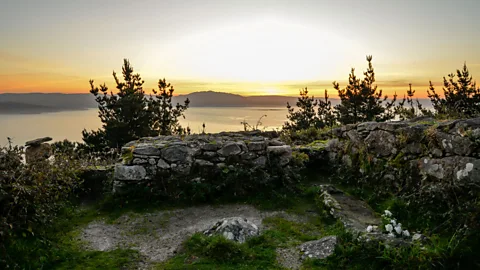 Olivier Guiberteau
Olivier GuiberteauThe final few kilometres of the Finisterre section of the Camino de Santiago wind along the coast, ending at the lighthouse at Monte Facho’s southern tip where the bronze boot is. For those who have walked from St-Jean-Pied-de-Port in south-west – the traditional beginning of the French Way, the Camino’s most popular route – these are the final steps of an 870km journey.
A symbolic distance marker showing 0.0km sits just north of the lighthouse, behind which lies a wide craggy area that descends almost like a natural amphitheatre before plunging off the edge. This is where pilgrims would burn an item of clothing as an act of re-birth. The practice is now banned, but a few scorched rocks remain. Instead, small pieces of clothing are sometimes tied to the bushes squeezed between the rocks.
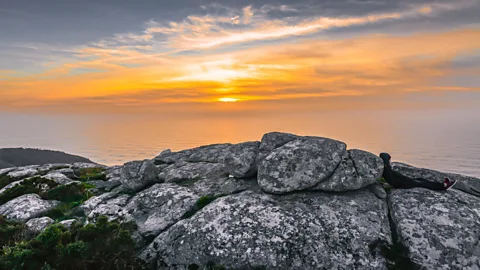 Olivier Guiberteau
Olivier GuiberteauIf travellers from long ago did make their way to witness a sunset from the spot where the Ara Solis once stood, it’s likely that at the end of the day they pursued the climb to the summit of Monte Facho. Here, three rocky outcrops lie among a sea of thick, prickly plants. The furthest north is known as Piedras Santas, or Holy Stones, and is where, according to legend, the Virgin Mary is said to have rested after journeying to Finisterre to encourage St James in his apostolic duties.
The view from the Piedras Santas is wild and spectacular. The cliffs drop dizzyingly to the Atlantic stretching out to the horizon. The Romans believed this area to be the gateway to the afterlife and where the sun went each night to die.
“There isn’t the same overwhelming amount of distractions as in other places,” said Carlota Traba, whose father was born in the lighthouse, “you simply sit with the rocks, the water and the sunset – that’s the magic”.
“You can’t go any further emotionally, spiritually and physically,” Jones added. This is the end of the road.
more than three million BBC Travel fans by liking us on Facebook, or follow us on Twitter and Instagram.
If you liked this story, sign up for the weekly bbc.com features newsletter called "If You Only Read 6 Things This Week". A handpicked selection of stories from BBC Future, Culture, Capital and Travel, delivered to your inbox every Friday.
{"image":{"pid":""}}
